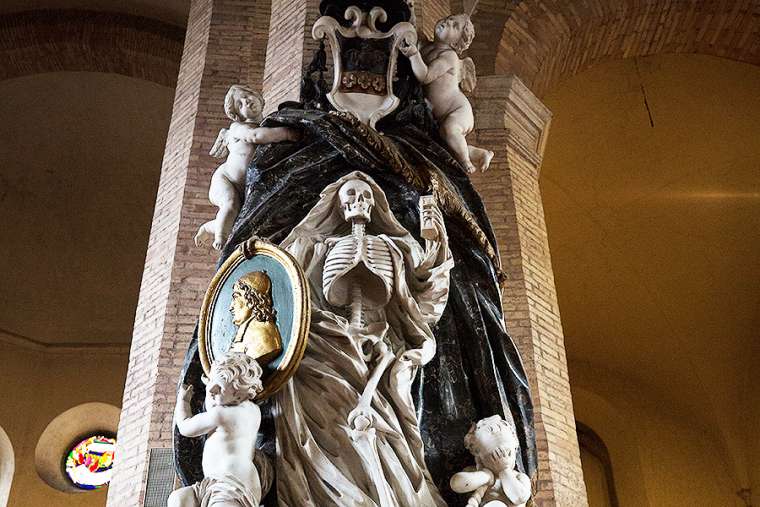A memento mori at the Teutonic Cemetery in the Vatican. Credit: Daniel Ibanez/CNA.
Whether you dress up as a ghost, a hero, or a saint, Halloween has a Christian origin that should inspire us to remember our mortality and our redemption in Christ, Bishop David Konderla of Tulsa has said.
“In contrast to popular culture’s observance of Halloween, even the customary appeal to the ‘frightful’ has a devotional meaning in the Catholic tradition. Props such as skulls and scythes have historically recalled our mortality, reminding us to be holy because we are destined for judgment,” the bishop said, citing Hebrews 9:27 and Revelation 14:15. “Visible symbols of death thus represent a reminder of the last things – death, judgment, Heaven, and hell.”
Halloween has origins in the Catholic liturgical calendar, he said, but the customs surrounding it have “drifted from the feast’s intended meaning and purpose.” The name itself derives from the archaic English phrase “All Hallows’ Evening,” referring to the Eve of All Saints. Since All Saints can begin with evening prayer the night before, Halloween is the feast’s “earliest possible celebration.”
“While the ‘Gothic’ aspect of Halloween reminds us of Christian teaching about the resurrection of the dead, our culture often represents this in a distorted manner, for when the dead are raised they will in truth be ‘clothed with incorruptibility’,” said Bishop Konderla.
When separated from Catholic teaching, the holiday’s grim, ghoulish, or “Gothic” costumes can be mistaken as “celebration or veneration of evil or of death itself, contradicting the full and authentic meaning of Halloween.”
“For the Christian, Christ has conquered death, as has been prophesied and fulfilled,” he said. “Christ has conquered death by his Passion, Death, and Resurrection, the Paschal Mystery whose graces are evident in the glory of all saints.”
The bishop also discussed the custom of dressing up as Christian saints.
“The custom of dressing up for Halloween is devotional in spirit,” he said. “By dressing up as the saints whom we most admire, we imagine ourselves following their example of Christian discipleship. This practice allows the lay faithful in festive celebration to become ‘living icons’ of the saints, who are themselves ‘icons’ or ‘windows’ offering real-life examples of the imitation of Christ.”
“In dressing up as saints we make Christian discipleship our own in a special way, following the exhortation of St. Paul: ‘Be imitators of me, as I am of Christ’,” he said, citing Paul’s First Letter to the Corinthians.
Bishop Konderla invoked the imagery of the saints used in the Book of Revelation.
“Proper veneration of the saints naturally leads to adoration of the Lamb who was slain, whom the saints adore and follow wherever he goes,” he said. “True devotion to the saints, through our prayers and imitation of their witness, leads us, sinners, back to Christ.”
The bishop also voiced a few warnings. He said it is important to avoid Halloween popularisations of things that are contrary to the Catholic faith. These include the glamorisation or celebration of “anything involving superstition, witches, witchcraft, sorcery, divinations, magic, and the occult.”
“We want to be good models of Christian virtue for those we serve and make clear distinctions between that which is good and that which is evil,” he added.
“Let us urge one another this Halloween to express in every detail of our observance the beauty and depth of the Feast of All Saints,” Bishop Konderla concluded.
“Let us make this year’s celebration an act of true devotion to God, whose saints give us hope that we too may one day enter into the Kingdom prepared for God’s holy ones from the beginning of time.”
This article was first published by CNA in 2018
Source: CNA

